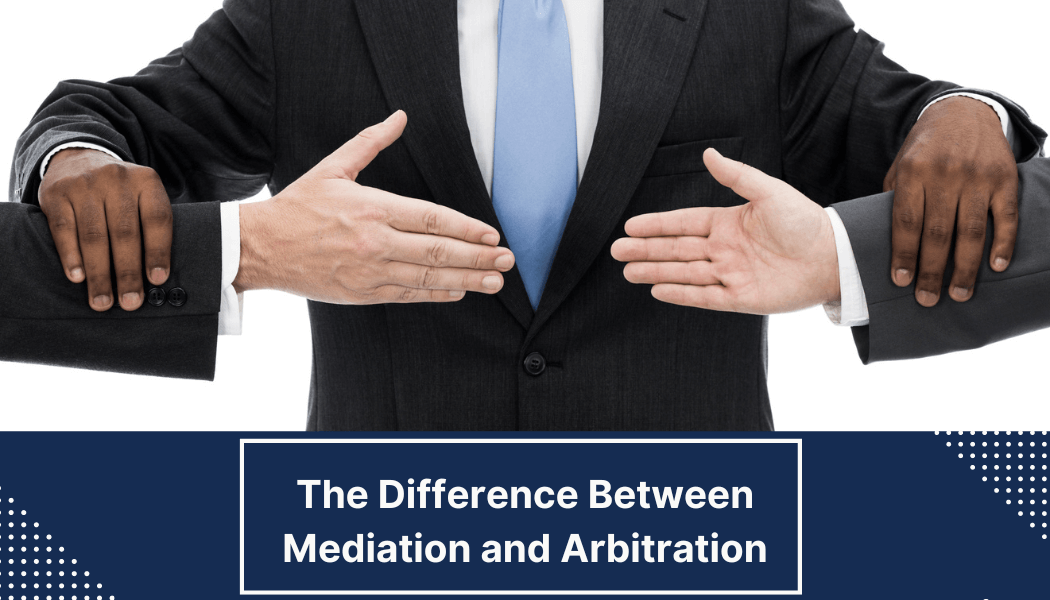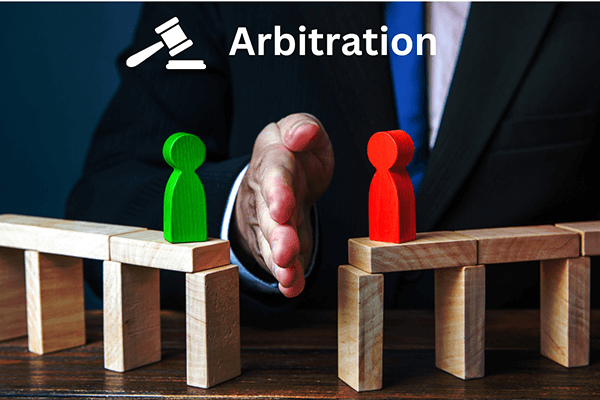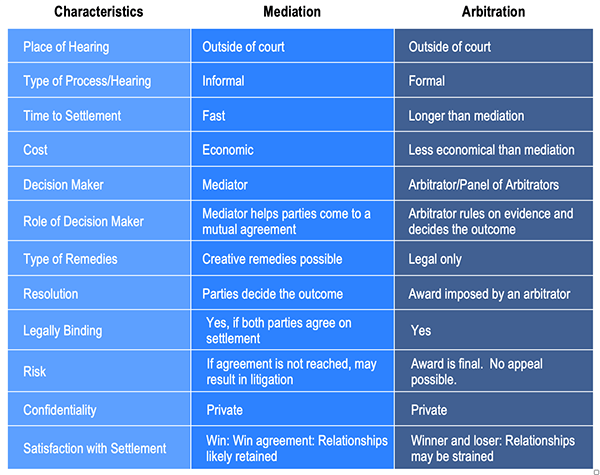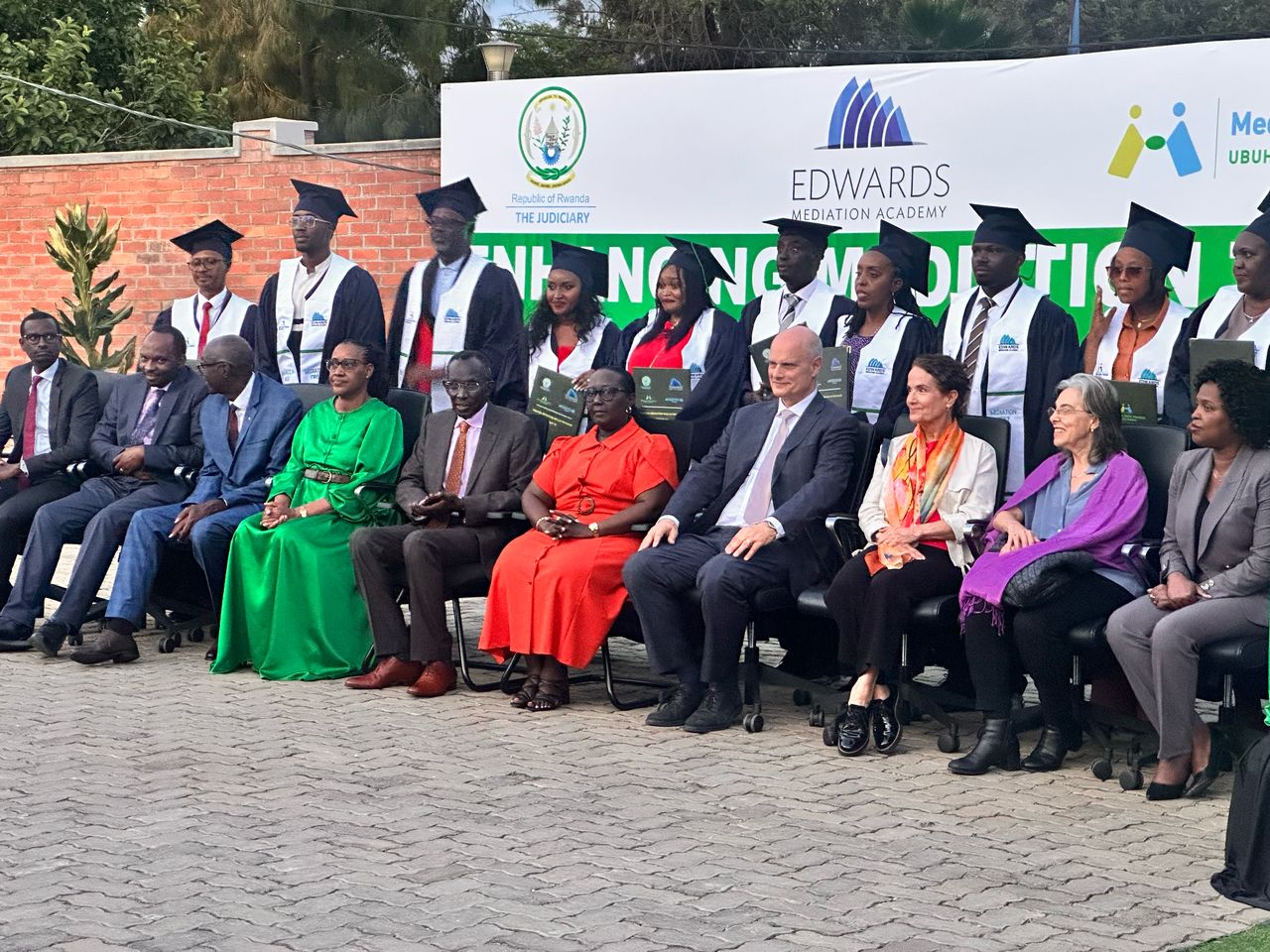Arbitration and mediation share a common lineage as alternatives to the traditional legal system of court and jury trials. Known as different forms of alternative dispute resolution (ADR), they are both intended to offer less expensive, more efficient outside-of-courtroom approaches to resolving disputes than afforded by more formal litigation. Yet there, the similarities end. The difference between arbitration and mediation lies in their distinctively different approach to conflict resolution.
The Continuum of Processes Available to Resolve Disputes
To best understand these important distinctions, it’s helpful to envision the dispute resolution process along a continuum of choices. To the far left lie the less formal, less expensive, and voluntary processes, including conciliation and mediation. As one moves conceptually toward the right end of the continuum, one moves towards the more formal tribunals like arbitration until reaching the most formal approach to dispute resolution — litigation — the civil trial and appellate court process itself.
Alternative Dispute Resolution for Resolving Disputes
Before deciding on an alternative to litigation for pursuing a conflict, it is essential to understand the key differences between mediation and arbitration. Mediators are often chosen for their conflict resolution skills and legal knowledge, which help them facilitate discussions and guide parties toward a resolution.
What is Arbitration?
Arbitration is a method of resolving a legal dispute outside of the court system in which the disputants present their case to an impartial third party, who then makes a final decision to resolve the conflict. Historically, arbitration was synonymous with this alternative form of dispute resolution as it was the first process developed to save the time and expense of protracted litigation.
Situated to the right of the center of this continuum, arbitration is more formal than mediation or conciliation and can look more like the litigation process. That is because, like litigation, arbitration is, at its core, an evidence-based, adjudicative process.
Arbitration involves a hearing resembling a trial that takes place outside the courtroom, requiring the parties in dispute to participate. The process is conducted according to formal rules of arbitration administered by a single neutral arbitrator (or a panel of arbitrators) whose task is to conduct a formal hearing, including lay and expert testimony.
Like a trial, the hearing can often take weeks to complete. Once testimony is concluded, the arbitrator rules on the evidence presented by issuing a decision. The arbitrator’s decision is a binding decision, providing a conclusive resolution to the dispute (unless the parties previously agreed to a non-binding arbitration). Because the decision is final, there is no formal appeals process available. Even if one party feels the outcome was unfair, unjust, or biased, they cannot appeal it. Unlike mediation, in arbitration, there are no discussions about working out the parties’ differences.
Arbitration is typically compelled by contract or statute, although parties can also agree to arbitrate after a conflict occurs. A contract that includes an agreement to arbitrate disputes (an arbitration clause) will outline some key aspects of any potential future arbitration. The rules and procedures that will be used in arbitration are typically part of this agreement. If a third-party ADR service such as JAMS or AAA will be used to handle an arbitration, the contract may specify whether the rules and procedures of that third-party service will be used. Rules typically address:
Number of arbitrators
Selection of arbitrators
Timeline for arbitration
Evidence
Awards
Confidentiality and records
The Arbitration Process
The main phases of an arbitration process include:
Initiation: An arbitration case begins when one party submits a demand for arbitration, which outlines the parties involved, the nature of the dispute, and the relief being sought.
Selection of Arbitrator: Both parties identify and select an arbitrator
Preliminary Hearing: Conducted by the arbitrator, a preliminary hearing with the parties may be held to discuss the issues in the case witnesses, depositions, sharing information, and other procedural matters.
Discovery: The parties identify witnesses, evidence, and experts, exchange information, and prepare for the hearing.
Hearing: At the hearing, parties present testimony and evidence to the arbitrator. Unless the case is very complex, there is usually only one hearing before the arbitrator.
The Award: The arbitrator concludes testimony, closes the record on the case, and issues a final decision, including an award.
What is Mediation?

A more recent alternative to court processes is mediation, often defined as a facilitated negotiation. In mediation, two or more parties meet outside of court with a qualified and neutral third party, the mediator, and discuss their various issues to try to reach an agreement and final settlement. In commercial mediation, lawyers represent the disputants and are referred to as Mediation Advocates.
Mediation is a flexible, private process reflecting the dispute’s unique requirements and the parties’ underlying needs and interests. Typically, mediation involves a combination of face-to-face discussions with the parties and private meetings with the mediator. Because there is no formal presentation of evidence, mediation can often be called upon early in a dispute before the parties’ positions harden and costs become another component of the conflict.
Perhaps most importantly, mediation differs from arbitration in that the mediator’s role is to assist the parties in finding common ground and fashioning a solution of their choosing. Unlike arbitration, the mediator’s role is to facilitate difficult conversations, not to sit in judgment of the parties. In other words, the mediator helps the parties communicate effectively to reach a mutually beneficial solution that minimizes conflict and animosity. Disputing parties maintain control of decisions impacting the outcome of the dispute and their lives. If and only if the parties voluntarily agree on an optimized solution, they will move toward concluding the dispute.
As a voluntary, non-binding process, many courts and contracts will require mediation as a first step in a stair-step approach to other, more formal dispute resolution processes. These advantages are capped with an appreciation that mediation is successful more often than not and can often be successfully implemented in a single day or less. It is considered the preferred alternative, particularly where the fallout of an adverse arbitration ruling might otherwise destroy an ongoing relationship between the parties.
The Mediation Process
More and more, courts are adopting mandatory requirements for mediation as a first step in solving civil disputes. In cases where mediation remains discretionary, most parties initiate mediation before or sometimes after litigation has been undertaken, without any involvement by the court. This could be at one of the following critical junctures in a case:
At the outset, following a demand letter or service of the complaint
Just after a dispositive motion has been filed and is pending
After the completion of limited but critical discovery
On the eve of trial, following the completion of expert discovery
Selection of the mediator: Once the two parties have agreed to mediate, they jointly agree on a neutral third party to mediate the case. The opposing parties should try to find a mediator who is knowledgeable about the subject matter of their case, has experience litigating or mediating similar cases, and whom they think has the mediation skills necessary to bring the opposing parties together in a settlement.
The Mediation Brief: Once a mediator is chosen, the parties submit to the mediator copies of briefs and exhibits that they may have filed in court or may have created for the mediator. A mediation brief is a central tool for the mediator to understand the factual, legal, and practical issues affecting settlement. An effective mediation brief includes a concise statement of material facts, applicable law, damages, and settlement expectations, wrapped in a historical overview of the case.
In-person mediation session: The mediation is held in an office, usually provided by the mediator, not in the courthouse. The parties, their lawyers, and the mediator attend the session. The typical length of mediation is less than one day.
Joint meetings: Mediation in a complex case typically begins with all parties, their attorneys, and occasionally experts assembled for a joint meeting to present the facts and legal arguments to the other parties, attorneys, and the mediator.
Private caucuses: Following the joint meeting, particularly in commercial mediation, the mediator will typically separate the parties and begin meeting with them in a series of private, confidential meetings, or “caucuses.” In the caucuses, the mediator works with each side to discuss the strengths and weaknesses of the case, bring the parties’ positions closer together, and explore settlement opportunities. Either or both parties can decline to accept settlement offers.
Closing the mediation: The goal of mediation is to obtain a durable settlement agreement acceptable to all parties. If a settlement is reached, the mediator will draft, and the parties will execute, a binding settlement agreement that will include the dismissal of the case or the entry of an agreed judgment. The mediator may encourage the parties to reconvene to continue settlement efforts if no settlement is achieved.
Comparison of the Key Characteristics of Arbitration and Mediation
By understanding the key characteristics and the pros and cons of arbitration and mediation, disputing parties can decide on the process that best suits their needs.
What is Better, Mediation or Arbitration?
Both arbitration and mediation have their advantages and disadvantages. Both are effective ways of solving disputes outside of court that are faster and more economical than traditional litigation and take place outside the public eye.
According to the American Bar Association, both processes offer effective ways to resolve disputes outside of court. Both processes can address a wide range of legal issues in family, commercial, employment, and other types of disputes. The main difference between the two is the role of the ADR professional as a facilitator (mediator) versus a decision-maker (arbitrator).
Certain situations, nevertheless, may benefit from mediation rather than arbitration. Meditation may be the preferred option when:
Both parties believe they can reach an understanding on their own terms.
It is the first attempt to deal with a conflict, and it will likely not escalate to arbitration or litigation.
The parties will continue working together and must maintain an ongoing relationship despite disagreement.
Mediation in civil disputes often involves business partners, landlords and tenants, labor unions, and management. Mediation is one of the most commonly used ADR methods in the construction industry and is becoming increasingly more prevalent in franchise law.
Arbitration may be preferred over mediation in other conflicts—particularly those with high stakes or complexity. Arbitration may be a better option than mediation when:
A legal matter has escalated and become a more serious issue
Both parties have not been able to settle on an agreement
Generally, arbitration is used to resolve a dispute before going to court. It is widely used to resolve a wide range of commercial disputes. Arbitration clauses are found in many construction contracts, contracts for selling consumer and business products, contracts between employers and employees and between co-owners of a company, and in many other situations. Some agreements, such as insurance contracts, require a dispute to be resolved by arbitration and not by the traditional court system.
In Conclusion
Many disputants, in-house counsel, courts, and judges are demonstrating a strong preference for mediation, arbitration, and other forms of alternative dispute resolution for resolving conflicts outside the courtroom. Offering a less expensive, more efficient option to traditional litigation, they are effective methods of resolving civil disputes of all complexities.
By understanding the difference between arbitration and mediation and their place on the continuum of ADR processes, parties in a dispute can decide on the process that best suits their needs.








